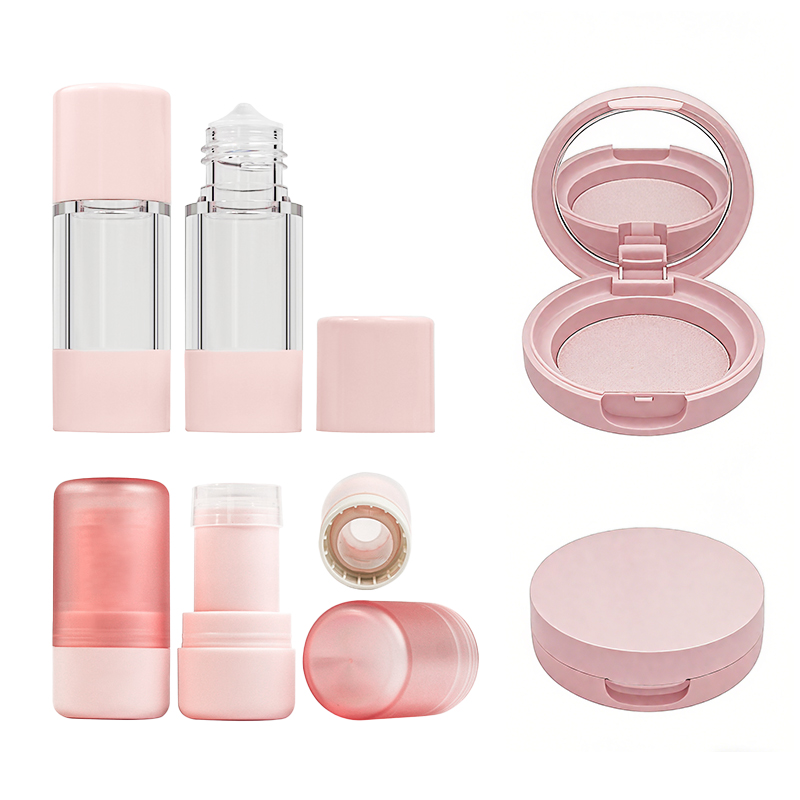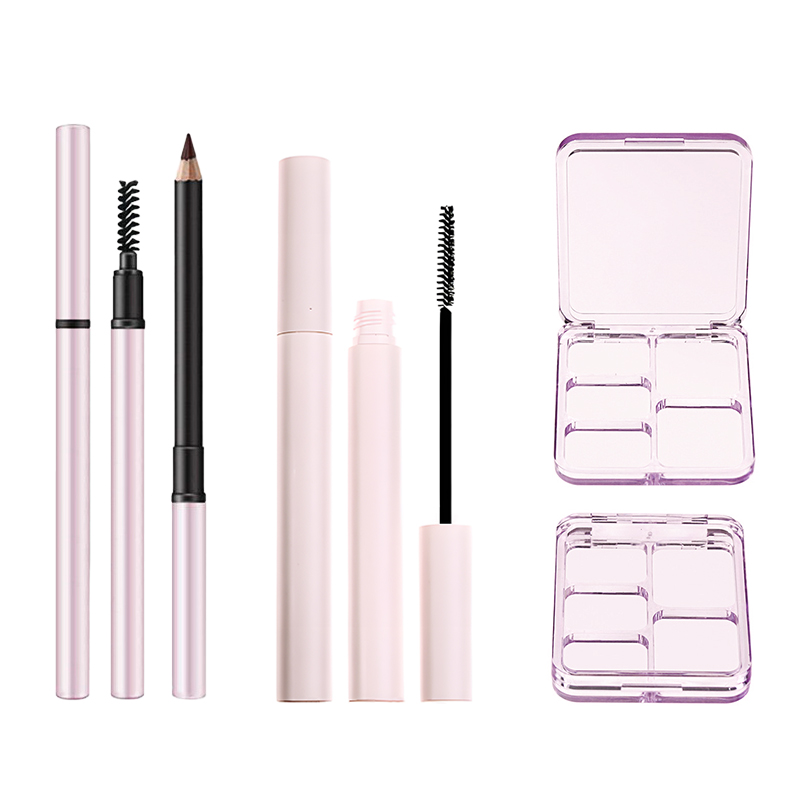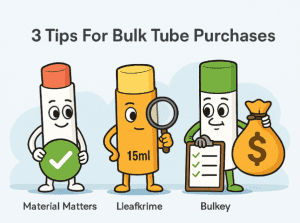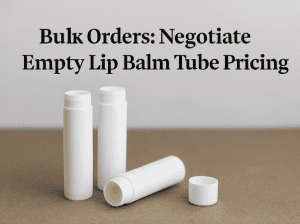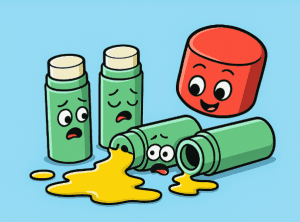Quick Tips for Purchasing Empty Lip Balm Tubes
You’ve got a hot new lip balm formula and dreams of building your brand—but now you’re staring at pages of empty lip balm tubes online, wondering why half of them look like they belong in a kindergarten art box. Do you go with plastic? Metal? The ones that claim to be “eco-friendly” but feel flimsier than grandma’s Tupperware lid from 1982? Buying in bulk sounds smart—until you’re knee-deep in mismatched lids and warped barrels.
Truth is, sourcing packaging isn’t just about price tags—it’s a mix of durability, vibes, volume sizes, and knowing if the supplier will ghost you after your PayPal clears. You’ve gotta think like a buyer and a designer. Because let’s face it: no one wants their product to melt into someone’s pocket or leak all over an influencer’s purse during unboxing.
Key Points for Bulk Buying Success: A Quick Guide to Empty Lip Balm Tubes
-
Material Matters: Choose between plastic, aluminum, or eco-friendly options depending on your brand’s vibe and durability needs. Aluminum offers sleekness and protection, while recycled plastics can support sustainability claims.
-
Volume Variety: Match tube sizes (5ml, 15ml, 30ml) with customer habits—smaller for travel-friendly balms; larger for value-packed formulas.
-
Bulk Budgeting Basics: Aim for orders of 5000+ units to unlock wholesale discounts without stretching your budget too thin; balance volume with realistic sales forecasts.
-
Seal the Deal: Prioritize leak-proof caps and BPA-free seals—especially if you’re planning a refillable product line or shipping in warmer climates.
-
Ship Smart: Use recyclable cushioning and structured packaging when sending out large batches (5000–10,000 units) to avoid transit damage—and keep those unboxing videos influencer-ready!
3 Tips For Bulk Tube Purchases
Buying in bulk? Smart move—if you know what to look for. These three sharp tips will help you avoid costly mistakes and pick the best material, size, and quantity.
Material Matters: Plastic, Aluminum, and Eco-Friendly Tubes
Not all tubes are created equal. Choosing the right material can make or break your product’s vibe—and its shelf life.
- Plastic is super lightweight and budget-friendly but can feel cheap if not chosen carefully. Look for bpa-free options to keep things safe.
- Aluminum brings a premium feel. It’s sturdy, sleek, and blocks out light—great for sensitive formulas.
- Compostable or biodegradable options? That’s where eco-conscious brands shine. These eco-friendly tubes are gaining traction fast.
According to Mintel’s 2024 Sustainable Packaging Report, “72% of Gen Z consumers prefer products packaged in recyclable or biodegradable materials.” So yeah—it matters.
Finding the Perfect Volume—5ml, 15ml, or 30ml Lip Balm Tubes
Size isn’t just about looks—it affects cost-per-unit, portability, even how often folks re-buy.
- Go tiny with 5ml tubes if you’re after samples or pocket-sized convenience.
- The middle ground? 15ml sizes hit that sweet spot between value and portability.
- For serious users or multi-use balms (think cheek tint + lip balm), go big with a 30ml tube.
Each size plays a role depending on how your customers use their balm—and how much they’re willing to carry around.
Negotiate Empty Lip Balm Tube Pricing
Smart buyers know—big orders mean big wins. Here’s how to get the most bang for your buck when buying balm packaging in bulk.
Research Recycled vs. BPA-Free Tubes for Cost Efficiency
♻️ Recycled plastics might sound eco-friendly, but they aren’t always the cheapest choice. BPA-free options often come with lower manufacturing costs and better consistency in quality.
• Recycled tubes may require additional processing, bumping up price per unit.
• BPA-free plastic is more readily available, meaning fewer supply-chain hiccups.
• Some suppliers mix both materials without clear labeling—always double-check specs.
• When comparing suppliers, ask for a breakdown of materials cost by unit type.
A quick glance at typical price ranges:
| Tube Type | Avg Unit Cost (USD) | MOQ (Units) | Lead Time (Days) |
|---|---|---|---|
| 100% Recycled | $0.17 | 5,000 | 20–25 |
| BPA-Free Plastic | $0.13 | 5,000 | 12–18 |
| Mixed Composition | $0.15 | 6,000 | 15–22 |
If you’re aiming for both savings and safety, BPA-free might be the sweet spot.
Leverage 10000+ Unit Orders to Unlock Wholesale Discounts
Ordering over five thousand? You’re officially playing in the big leagues—and that means it’s time to talk wholesale perks.
1️⃣ Most manufacturers start offering tiered pricing once you hit this volume.
2️⃣ Ask upfront about discount thresholds—some give price breaks at just 3k units.
3️⃣ Don’t forget shipping consolidation; ordering in bulk slashes freight costs too.
4️⃣ Brands like Topfeel often toss in free customization or upgraded packaging with large orders.
💡 Pro tip: Always request a sample batch before committing to thousands—it’s cheaper than fixing mistakes later.
Partnering with Suppliers: Securing UV Protection and Leak-Proof Features
You don’t want oily leaks turning your product into a sticky mess—or worse, sun damage degrading your formula before it hits shelves.
☑️ Lock down these two must-haves when choosing your supplier:
• UV-blocking additives baked into the tube’s resin—not just an outer coating
• Seamless construction and tight snap-fit caps for reliable sealing
🔍 Ask potential partners if they offer lab-tested validation reports on UV resistance and pressure testing stats for leak-proof claims.
Reliable supplier relationships aren’t just about pricing—they’re about long-term trust and consistent quality control across every shipment of balm tube parts you order.
Leaking Empty Lip Balm Tubes? Secure Caps Prevent Spills.
Even the slickest cosmetics packaging can go sideways if your caps aren’t pulling their weight. Let’s talk leak-proofing—because no one wants melted balm in their bag.
Choosing Leak-Proof Caps for Plastic and Aluminum Tubes
Caps that don’t seal properly? Recipe for disaster. When looking at closures for your plastic or aluminum balm containers, here’s what to keep an eye on:
• Snap-fit vs screw-top caps—screw-tops usually win on tightness but can slow down filling lines.
• For soft squeeze tubes, ribbed edges give better grip and reduce twist-off accidents.
• Look for inner sealing discs or silicone liners inside the cap; they’re often overlooked but critical for preventing leaks.
A recent report by Mintel Global Packaging Insights, Q1 2024, noted that “over 61% of consumers consider a product’s closure system when judging its quality.” This makes investing in smarter closure designs more than just a technical decision—it’s about brand trust.
Lastly, don’t skip real-world testing. Drop tests, heat chamber trials, and even handbag simulations can reveal flaws early before they hit store shelves.
Testing Refillable and BPA-Free Seals Before Bulk Orders
Before you commit to thousands of units, make sure your seals are doing more than just looking good—they need to perform under pressure.
🟢 Here’s how different materials stack up:
| Seal Type | Reusability Score (/10) | BPA-Free Certified | Heat Resistance (°C) |
|---|---|---|---|
| Silicone Insert | 9 | Yes | Up to 120°C |
| Polypropylene Cap | 7 | Yes | Up to 100°C |
| LDPE Plug | 5 | No | Up to 80°C |
| TPE Gasket | 8 | Yes | Up to 110°C |
✔ For refillable formats, opt for high-flexibility gaskets that don’t deform after repeated use.
✔ If you’re using aluminum tubes with threaded necks, pair them with lined screw caps that resist warping under heat exposure during shipping or storage.
Also important? Don’t assume “BPA-free” means safe across the board—always ask suppliers for full resin traceability reports before signing off on bulk orders.
Getting this right means fewer returns, happier customers—and no more messy surprises in anyone’s purse from leaky balm disasters.
E-commerce Packing: Secure Tube Shipment
Smart packaging isn’t just about wrapping things up — it’s about keeping products safe, eco-friendly, and easy to ship without breaking the bank or your brand image.
Cushioning Options for 5ml to 50ml Lip Balm Tubes
- Bubble wrap pouches with self-seal flaps work great for small tubes. They’re light and give solid impact protection.
- Foam inserts cut to size cradle each tube, especially handy when shipping custom sizes like 7ml or 15ml.
- Corrugated dividers inside boxes prevent rattling during long-distance hauls — no more leaky messes on arrival.
- For bulk orders, molded pulp trays stabilize dozens of items at once while staying biodegradable.
- Kraft paper nests are ideal for mid-range volumes; they contour easily around tubes without adding too much weight.
✦ Never underestimate double-walled mailers — they’re budget-friendly armor for fragile items like balm sticks or mini airless containers.
Short tubes often get tossed around in transit. That’s where smart cushioning steps in — not just to protect but also to avoid returns due to damage during shipment.
When you’re dealing with different fill sizes — say 5g samplers versus full-size 50g balm sticks — every layer of padding counts toward product safety and customer satisfaction.
Bundling Lip Balm Tubes and Airless Pumps in Recyclable Packaging
• Grouping similar-sized balm sticks and airless pump bottles into compact trays reduces movement and waste inside the carton box.
• Use paperboard sleeves printed with your logo as outer wraps — instant branding opportunities, plus they keep items snugly together during shipping.
• Consider honeycomb kraft sheets instead of plastic films; they’re compostable yet strong enough for tight bundling across mixed items like twist-up balms and push-bottom dispensers.
Multiple smart moves here:
– Match product weights before bundling—grouping heavy airless pumps with lighter balm tubes can cause shifting unless balanced properly.
– Opt for certified FSC cardboard cartons when possible; it reinforces your brand’s commitment to sustainable materials without sacrificing durability.
– Add tamper-evident seals made from biodegradable film so customers feel confident their goods arrived untouched.
Topfeel nails this by offering pre-bundled packs with recyclable trays that hold everything from tester-size balms to full-body moisturizers—no extra assembly needed at fulfillment centers!
FAQs
Choosing the right material isn’t just about price—it’s about what your brand stands for. If you’re aiming for affordability and ease, plastic is a solid choice. But if you want to give customers that satisfying click of quality when they twist open a tube, aluminum often wins hearts. And if sustainability speaks louder than anything else, biodegradable or recycled options let your product whisper its values before it even touches lips.
Absolutely—large orders usually unlock:
- Tiered pricing with noticeable drops per unit
- More efficient shipping costs due to volume consolidation
- Faster production slots from manufacturers who prioritize high-volume clients
It pays off—literally—to plan big.
Yes—and not just technically. A leaky cap doesn’t just ruin product; it erodes trust. When someone opens their package and finds sticky residue where there should be clean precision, it reflects poorly on everything else you’ve worked so hard to build.
Each size tells its own story:
- 5ml: Perfect for samples or travel pouches—small enough to tuck into any pocket but still packs impact.
- 15ml: The everyday go-to; familiar in hand and ideal for regular use.
- 30ml: Bold and generous—for those who want more than just a swipe here and there.
Think about how your customer lives day-to-day—that’s where the answer lies.
Yes! Many suppliers now offer eco-conscious inserts like molded pulp trays or cardboard dividers that cradle both items securely while keeping waste minimal. It’s thoughtful design meeting practical function—a rare harmony in mass production.
Because one bad batch can undo months of careful planning. Testing ensures every seal holds under pressure—not only during shipping but also after repeated use by real people tossing these into bags, pockets, glove compartments… You’re not just testing containers—you’re protecting reputations.

